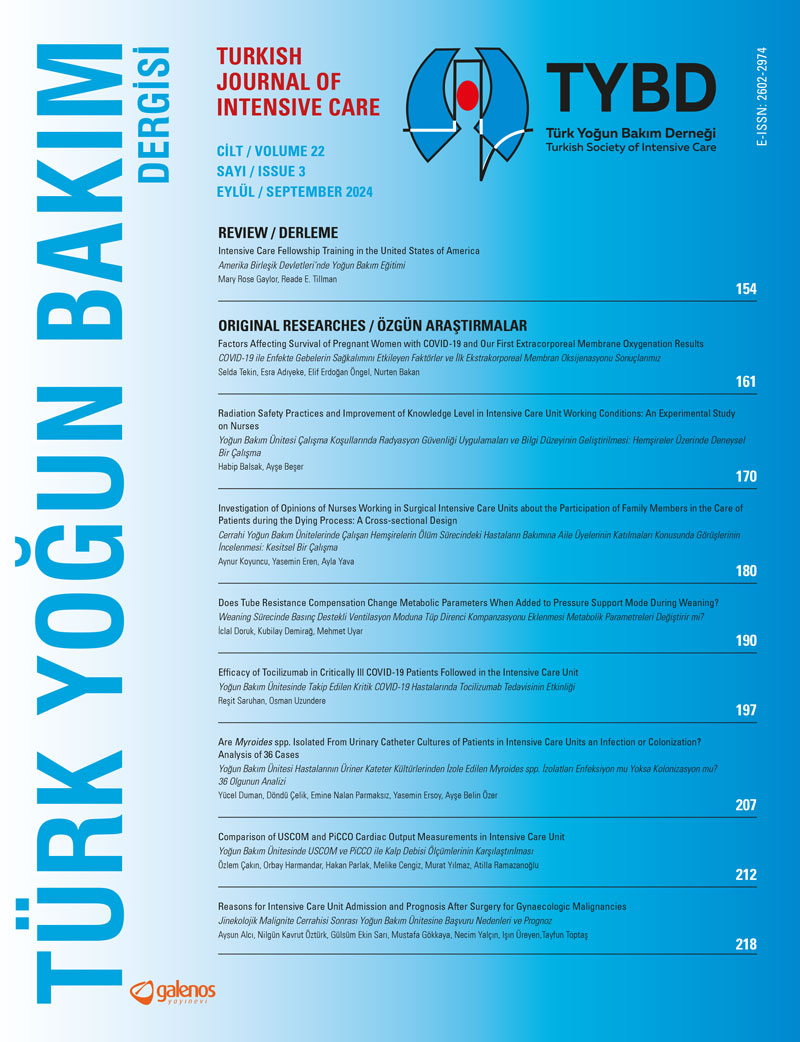Öz
Amaç
Bu çalışmanın amacı jinekolojik malignitelerin cerrahi tedavisi sonrası yoğun bakım ünitesine (YBÜ) yatış ve prognoz ile ilişkili faktörleri araştırmaktır.
Gereç ve Yöntem: Bu çalışma, 1 Aralık 2022 ile 1 Aralık 2023 tarihleri arasında jinekolojik onkolojik cerrahi uygulanan ve sonrasında YBÜ izlenen hastaları kapsayan retrospektif bir kohort analizi olarak tasarlanmıştır.
Bulgular
Çalışma döneminde jinekolojik onkolojik cerrahi geçiren ve YBÜ kabul edilen 57 hastanın verileri analiz edildi. Medyan yaş 61,47, medyan vücut kitle indeksi 27 kg/m2, Amerikan Anesteziyoloji Derneği skoru 3±2,5 idi. YBÜ kabul için en yaygın endikasyon %73,6 (n=42) ile hemodinamik instabilite iken, bunu %15,7 (n=9) ile solunum yetmezliği, %10,5 (n=6) yerine solunum yetmezliği ve diğer nedenler izlendi. Charlson komorbidite indeksi, laktat ve baz açığı düzeyleri 3 gün ve üzeri YBÜ’de kalan hastalarda daha yüksek, albümin değerleri ise daha düşüktü (p=0,04, p=0,004, p=0,034, p=0,025). Çalışma süresi boyunca sadece 2 hastada (%3,5) mortalite gelişti.
Sonuç
Elektif jinekolojik onkoloji cerrahisi sonrası YBÜ takibi için en yaygın endikasyon hemodinamik instabilite olup, genel olarak YBÜ mortalitesi düşük ve YBÜ yatış süresi kısadır.
Anahtar Kelimeler: Komorbiditeler, jinekolojik onkoloji cerrahisi, yoğun bakım ünitesi
Referanslar
- Sung H, Ferlay J, Siegel RL, Laversanne M, Soerjomataram I, Jemal A, et al. Global Cancer Statistics 2020: GLOBOCAN Estimates of Incidence and Mortality Worldwide for 36 Cancers in 185 Countries. CA Cancer J Clin. 2021;71:209-49.
- Wang S, Zheng R, Li J, Zeng H, Li L, Chen R, et al. Global, regional, and national lifetime risks of developing and dying from gastrointestinal cancers in 185 countries: a population-based systematic analysis of GLOBOCAN. Lancet Gastroenterol Hepatol. 2024;9:229-37.
- Schwandt A, Andrews SJ, Fanning J. Prospective analysis of a fever evaluation algorithm after major gynecologic surgery. Am J Obstet Gynecol. 2001;184:1066-7.
- Dhanis J, Keidan N, Blake D, Rundle S, Strijker D, van Ham M, et al. Prehabilitation to Improve Outcomes of Patients with Gynaecological Cancer: A New Window of Opportunity? Cancers (Basel). 2022;14:3448.
- Heinonen S, Tyrväinen E, Penttinen J, Saarikoski S, Ruokonen E. Need for critical care in gynaecology: a population-based analysis. Crit Care. 2002;6:371-5.
- Namendys-Silva SA, González-Herrera MO, Texcocano-Becerra J, Herrera-Gómez A. Outcomes of critically ill gynecological cancer patients admitted to intensive care unit. Am J Hosp Palliat Care. 2013;30:7-11.
- Krawczyk P, Trojnarska D, Baran R, Lonc T, Swistek R, Tyszecki P, et al. Postoperative gynecologic oncology admissions to intensive care unit in the tertiary care center: an eight-year retrospective study. Ginekologia Polska. 2023;94:599-604.
- Abebe MM, Arefayne NR, Temesgen MM, Admass BA. Incidence and predictive factors associated with hemodynamic instability among adult surgical patients in the post-anesthesia care unit, 2021: A prospective follow up study. Ann Med Surg (Lond). 2022;74:103321.
- Reidy CM, Beach ML, Gallagher JD, Sites BD. Postoperative hemodynamic instability after simultaneous bilateral total knee arthroplasty. J Patient Saf. 2010;6:233-7.
- Summers C, Todd RS, Vercruysse GA, Moore FA. Acute Respiratory Failure. Perioperative Medicine. 2022:576-86.
- Canet J, Gallart L, Gomar C, Paluzie G, Valles J, Castillo J, et al. Prediction of postoperative pulmonary complications in a population-based surgical cohort. Anesthesiology. 2010;113:1338-50.
- Charlson ME, Pompei P, Ales KL, MacKenzie CR. A new method of classifying prognostic comorbidity in longitudinal studies: development and validation. J Chronic Dis. 1987;40:373-83.
- Zimmerman JE, Kramer AA. Outcome prediction in critical care: the Acute Physiology and Chronic Health Evaluation models. Curr Opin Crit Care. 2008;14:491-7.
- Brooks SE, Ahn J, Mullins CD, Baquet CR. Resources and use of the intensive care unit in patients who undergo surgery for ovarian carcinoma. Cancer. 2002;95:1457-62.
- Amir M, Shabot MM, Karlan BY. Surgical intensive care unit care after ovarian cancer surgery: an analysis of indications. Am J Obstet Gynecol. 1997;176:1389-93.
- Leath C, Kendrick J, Numnum T, Straughn J, Rocconi R, Sfakianos G, et al. Outcomes of gynecologic oncology patients admitted to the intensive care unit following surgery: A university teaching hospital experience. Int J Gynecol Cancer. 2006;16:1766-9.
- Ruskin R, Urban RR, Sherman AE, Chen L-l, Powell CB, Burkhardt DH, et al. Predictors of intensive care unit utilization in gynecologic oncology surgery. Int J Gynecol Cancer. 2011;21:1336-42.
- Thomakos N, Zacharakis D, Rodolakis A, Zagouri F, Papadimitriou CA, Bamias A, et al. Gynecologic oncology patients in the surgical high dependency unit: an analysis of indications. Arch Gynecol Obstet. 2014;290:335-9.
- Thomakos N, Prodromidou A, Haidopoulos D, Machairas N, Rodolakis A. Postoperative Admission in Critical Care Units Following Gynecologic Oncology Surgery: Outcomes Based on a Systematic Review and Authors' Recommendations. In Vivo. 2020;34:2201-2208.
- Momenimovahed Z, Tiznobaik A, Taheri S, Salehiniya H. Ovarian cancer in the world: epidemiology and risk factors. Int J Womens Health. 2019;11:287-99.
- Abbas FM, Sert MB, Rosenshein NB, Zahyrak ML, Currie JL. Gynecologic oncology patients in the surgical ICU. Impact on outcome. J Reprod Med. 1997;42:173-8.
- Van Le L, Fakhry S, Walton LA, Moore DH, Fowler WC, Rutledge R. Use of the APACHE II scoring system to determine mortality of gynecologic oncology patients in the intensive care unit. Obstet Gynecol. 1995;85:53-6.
- Hallqvist L, Granath F, Fored M, Bell M. Intraoperative Hypotension and Myocardial Infarction Development Among High-Risk Patients Undergoing Noncardiac Surgery: A Nested Case-Control Study. Anesth Analg. 2021;133:6-15.
- Díaz-Montes TP, Zahurak ML, Bristow RE. Predictors of extended intensive care unit resource utilization following surgery for ovarian cancer. Gynecol Oncol. 2007;107:464-8.
Telif hakkı ve lisans
Telif hakkı © 2024 Yazar(lar). Açık erişimli bu makale, orijinal çalışmaya uygun şekilde atıfta bulunulması koşuluyla, herhangi bir ortamda veya formatta sınırsız kullanım, dağıtım ve çoğaltmaya izin veren Creative Commons Attribution License (CC BY) altında dağıtılmıştır.






















